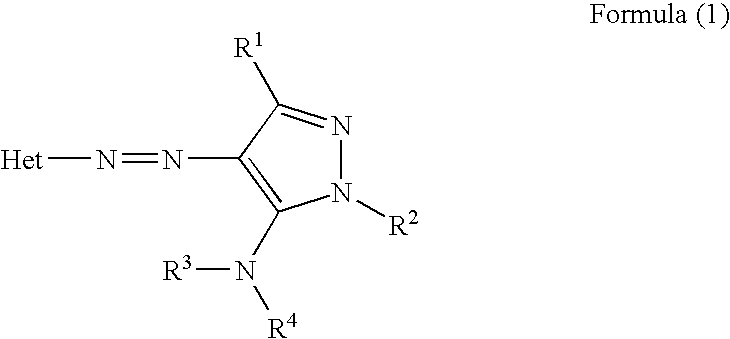Ink sheet for heat-sensitive transfer recording material, heat-sensitive transfer recording method, ink cartridge and azo dye
a heat-sensitive transfer recording and recording method technology, applied in thermography, monoazo dyes, duplicating/marking methods, etc., can solve the problems of extremely few heat-movable dyes which meet all the requirements, various limitations of heat-movable dyes used in this heat-sensitive transfer recording process, etc., and achieve excellent lightfastness and sharp hue
- Summary
- Abstract
- Description
- Claims
- Application Information
AI Technical Summary
Benefits of technology
Problems solved by technology
Method used
Image
Examples
synthesis example 1 (
Synthesis of Exemplary Compound (7))
[0093]
[0094]8.21 g (0.05 mol) of 5-amino-3-tert-butylpyrazole-4-carbonitrile, 15.4 ml of concentrated sulfuric acid, 10 ml of acetic acid and 15 ml of propionic acid were stirred at an internal temperature of from 0° C. to 5° C. To the mixture was then added dropwise a mixture of 3.45 g (0.05 mol) of sodium nitrite and 7.3 ml of water at an internal temperature of 5° C. The mixture was then stirred at an internal temperature of from 0° C. to 5° C. for 30 minutes. The diazonium salt solution thus obtained was then added dropwise to 100 ml of an acetonitrile solution of 10.7 g (0.05 mol) of 5-amino-3-tert-butyl-1-phenylpyrazole at an internal temperature of 10° C. or less. After the dropwise addition of the diazonium salt solution, the reaction solution was then stirred as it was for 30 minutes. The azo dye crystallized from the reaction system was suction-filtered, spray-washed with water and then with acetonitrile, and then dried at 60° C. overnig...
synthesis example 2 (
Synthesis of Exemplary Compound (8))
[0095]
[0096]To 2.50 g (0.0064 mol) of Exemplary Compound (7) were added 10 ml of dimethylacetamide, 0.88 g (0.0064 mol) of potassium carbonate and 0.40 ml (0.0064 mol) of iodomethane. The mixture was then stirred at room temperature for 60 minutes. After the termination of the reaction, to the reaction mixture was then added 50 ml of saturated aqueous solution of sodium chloride. The reaction mixture was then extracted with 50 ml of ethyl acetate. The resulting organic phase was dried over anhydrous salt cake, and then isolated by column chromatography (filler: silica gel; developing solvent: ⅔ mixture of ethyl acetate and hexane) to obtain Exemplary Compound (8). The yield was 1.03 g (40%). Exemplary Compound (8) thus obtained showed λmax of 432 nm (as measured in ethyl acetate solution).
synthesis example 3 (
Synthesis of Exemplary Compound (92))
[0097]
[0098]8.21 g (0.05 mol) of 5-amino-3-tert-butylpyrazole-4-carbonitrile, 15.4 ml of concentrated sulfuric acid, 10 ml of acetic acid and 15 ml of propionic acid were stirred at an internal temperature of from 0° C. to 5° C. To the mixture was then added dropwise a mixture of 3.45 g (0.05 mol) of sodium nitrite and 7.3 ml of water at an internal temperature of 5° C. The mixture was then stirred at an internal temperature of from 0° C. to 5° C. for 30 minutes. The diazonium salt solution thus obtained was then added dropwise to 100 ml of an acetonitrile solution of 6.95 g (0.05 mol) of 5-amino-3-tert-butyl-1-phenylpyrazole at an internal temperature of 10° C. or less. After the dropwise addition of the diazonium salt solution, the reaction solution was then stirred as it was for 30 minutes. The azo dye crystallized from the reaction system was suction-filtered, spray-washed with water and then with acetonitrile, and then dried at 60° C. overni...
PUM
| Property | Measurement | Unit |
|---|---|---|
| Percent by mass | aaaaa | aaaaa |
| Percent by mass | aaaaa | aaaaa |
| Percent by mass | aaaaa | aaaaa |
Abstract
Description
Claims
Application Information
 Login to View More
Login to View More - R&D
- Intellectual Property
- Life Sciences
- Materials
- Tech Scout
- Unparalleled Data Quality
- Higher Quality Content
- 60% Fewer Hallucinations
Browse by: Latest US Patents, China's latest patents, Technical Efficacy Thesaurus, Application Domain, Technology Topic, Popular Technical Reports.
© 2025 PatSnap. All rights reserved.Legal|Privacy policy|Modern Slavery Act Transparency Statement|Sitemap|About US| Contact US: help@patsnap.com



